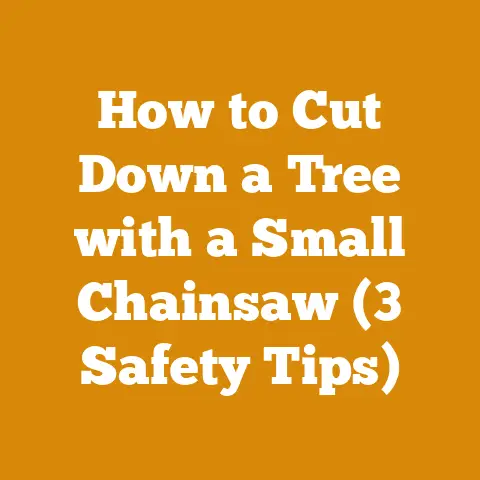How to Adjust Chainsaw Idle (4 Settings to Check)
Focusing on Family and Chainsaws
You know, every time I pick up my chainsaw, I’m reminded of the weekends spent with Dad in our backyard.
He was a lumberjack at heart, and those lessons have stuck with me.
We’d prepare for winter by cutting firewood together, a tradition that’s now become a family affair.
Anyone else feel that connection to family when they’re out there working?
For me, it’s more than just a task; it’s a link to memories and safety.
Why Adjust Chainsaw Idle?
Picture this: you’re in the middle of a project, and your chainsaw starts sputtering or stalls unexpectedly.
It can be downright frustrating!
But more than that, a poorly adjusted idle can lead to safety risks or inefficient fuel usage.
Understanding how to adjust the idle ensures your chainsaw runs smoothly, effectively, and safely.
Let’s get into tuning that idle so it purrs like a content kitten instead of coughing like an old jalopy.
Prerequisites and Required Materials
Essential Tools and Gear
Before diving into the adjustments, gather these essentials:
- Chainsaw toolkit: Includes a screwdriver tailored for your model.
- Owner’s Manual: Trust me, every chainsaw is a bit different.
- Protective Gear: Gloves, goggles, ear protection – you’ll thank yourself later.
Understanding Your Chainsaw
Familiarize yourself with the basic components of your chainsaw.
Know where the carburetor and idle screws are located.
If you’re not sure, your owner’s manual is a great guide.
Safety First!
Warning: Safety gear is non-negotiable.
Always wear gloves, goggles, and ear protection when working with chainsaws.
Ensure the chainsaw is on a stable surface with the chain brake engaged to prevent any accidental movement.
4 Critical Settings to Check
Alright, let’s break down these settings.
Adjusting a chainsaw idle involves fine-tuning four key components.
It’s like setting up a family meal – each dish has its own recipe but works together for the perfect feast.
1. Idle Speed Screw (T) Adjustment
This is where most of us start.
The idle speed screw controls how fast the engine runs without any throttle input.
My Personal Story with the Idle Speed Screw
I remember one time my chainsaw refused to stay running unless I kept revving it.
Frustrating!
It turned out the idle speed was set too low.
Here’s how I handled it:
Steps to Adjust
- Warm Up Your Chainsaw: Let it run for a few minutes.
A cold engine gives skewed results. - Locate the T Screw: Typically found near the carburetor, but check your manual.
- Adjust the Screw:
- Turn clockwise for a higher idle speed.
- Turn counter-clockwise for a lower speed.
Keep tweaking until the chain stops moving when idling but still runs smoothly.
Safety Tip
Always ensure the chainsaw chain is stationary at idle to prevent accidents.
2. Low-Speed Fuel Adjustment (L) Screw
This setting adjusts fuel mixture at low speeds, affecting how smoothly your chainsaw idles.
Adjusting the L Screw
- Turn the L Screw Slowly:
- Listen to the engine as you turn.
- Clockwise makes the mixture leaner (less fuel).
- Counter-clockwise enriches it (more fuel).
Aim for a steady engine sound without bogging down or sounding uneven.
Example from Experience
On one particular job, my chainsaw kept dying at low RPMs.
After some fiddling with the L screw, it was humming along perfectly.
3. High-Speed Fuel Adjustment (H) Screw
Though not directly linked to idling, this screw impacts overall performance at high speeds.
High-Speed Adjustment Steps
- Run at Full Throttle: Let ‘er rip!
- Adjust the H Screw:
- Clockwise if it sounds sluggish.
- Counter-clockwise if it’s sputtering or smoking.
This adjustment ensures your chainsaw performs well under load.
4. Throttle Position
Believe it or not, how you handle the throttle can affect idling too.
Throttle Handling Tips
- Practice gentle throttle control for smoother transitions.
- Avoid sudden speed changes; ease into it like you’re driving on ice.
Deep Dive into Safety Precautions
Chainsaws can be unforgiving if mishandled. Here are some crucial safety precautions:
- Chain Brake Usage: Always engage the chain brake when adjusting settings.
- Stability: Place your saw on a flat surface before making adjustments.
- Ventilation: Work in well-ventilated areas to avoid inhaling fumes.
Common Questions and Concerns
Why Does My Chainsaw Stall?
Chainsaw stalling is common but fixable:
- Check the idle speed setting.
- Clean or replace air filters.
- Use fresh fuel mixed correctly.
How Often Should I Adjust Idle?
Regularly inspect every few months or whenever performance issues arise.
What If I Can’t Get It Right?
If adjustments seem off:
- Revert to factory settings using your manual.
- Consult a professional if needed.
Troubleshooting Tips
For persistent issues:
- Check spark plugs; they might need cleaning or replacement.
- Ensure all screws are tightened correctly but not overly so.
- Inspect fuel lines for blockages or cracks.
Personal Experiences and Anecdotes
I remember a camping trip where the chainsaw was our lifeline for cutting firewood.
Adjusting the idle correctly beforehand made all the difference in keeping things running smoothly and safely.
Important Reminders
- Regular maintenance prevents costly repairs.
- Always double-check settings after making adjustments.
Next Steps After Adjustment
Once your idle is set perfectly:
- Test under different conditions (cold weather, high altitude).
- Perform regular maintenance checks on other components like air filters and spark plugs.
FAQ Section
What if My Chain Moves at Idle?
Revisit the T screw adjustment until it stops moving.
Can I Use Any Screwdriver?
Stick to the one recommended in your toolkit for precision.
Is Idling Related to Starting Issues?
Absolutely! Proper idle settings ensure smoother starts every time.
Adjusting your chainsaw’s idle isn’t just about performance; it’s about ensuring safety and efficiency for you and your family projects.
Involve your loved ones, make it a hands-on learning experience, and always prioritize safety above all else!






